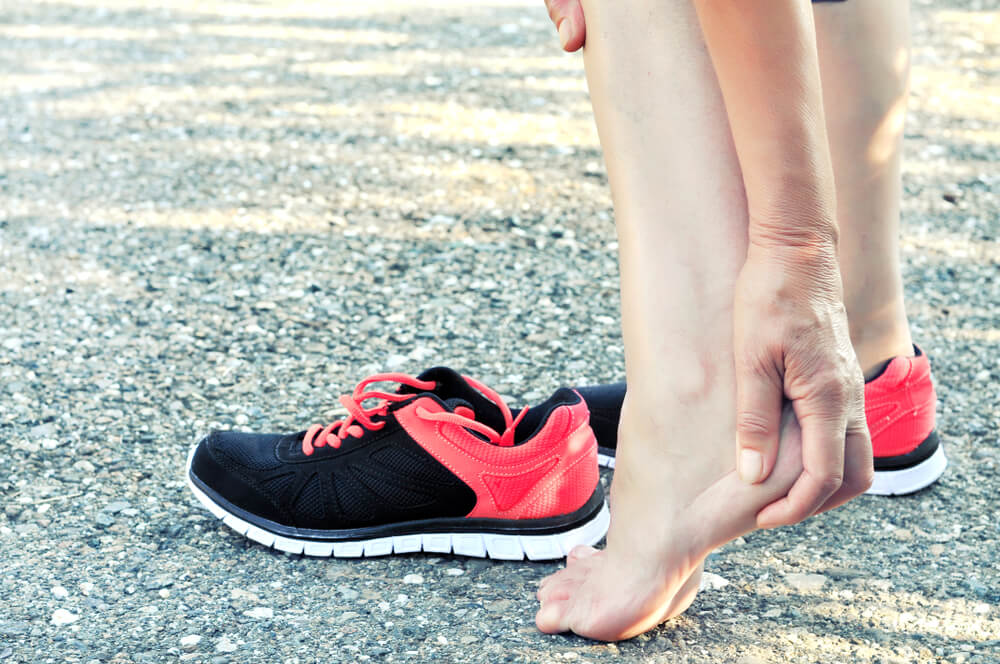You’re on your daily run and suddenly it is interrupted by a sharp pain in your heel. Thankfully, you don’t have to let heel pain while running ruin your routine. Continue reading to learn more about 4 reasons why you may have heel pain while running and 3 physical therapy techniques that can help reduce your pain.
4 potential causes for your heel pain while running
There are multiple conditions and injuries that may be responsible for your heel pain while running, such as:
- Irregular arches — If you have an irregular arch shape, such as very high or fallen arches (flat feet), you are at a higher risk for experiencing heel pain while running. Your feet play an important role in supporting your body through movements such as running or walking. When a part of the foot is misaligned, it places stress on other parts of the body, such as the plantar fascia. The plantar fascia is a thick ligament that runs along the bottom of the foot. It is responsible for supporting the arch of your foot, helping you walk and absorbing the shock of your steps. Placing stress on this ligament can cause heel pain while running or walking.
- Plantar fasciitis — Continued pressure and stress on the plantar fascia can develop into plantar fasciitis. This condition occurs when there are one or multiple tears within the plantar fascia. The damage causes the ligaments to become inflamed, and the inflammation causes heel pain and stiffness.
- Achilles tendinitis — The Achilles tendon is a large tendon that attaches your calf muscles to your heel bone. You use this tendon whenever you jump, walk or run. Like any other tendon in our body, the Achilles tendon can be damaged through repeated overuse or misuse. This type of injury is known as Achilles tendinitis. A common symptom of Achilles tendinitis is heel pain while running or the day after exercise.
- Arthritis — Although there are different types of arthritis, each has the potential to cause heel pain while running. Arthritis is an inflammatory disease that can cause pain and stiffness in any joint in the body. It is most common in small joints, such as those in the foot and ankle. The main types of arthritis that impact the foot and ankle are osteoarthritis, rheumatoid arthritis and post-traumatic arthritis. The inflammation caused by arthritis can make it difficult to walk, run or exercise without pain.
3 ways a physical therapist can help treat your heel pain
You may be able to temporarily relieve your heel pain using at-home methods such as pain medication, rest, or heat and cold therapy. A physical therapist can further support your healing and promote long-term health through the use of a variety of physical therapy techniques. Some PT techniques that your therapist may use as part of your treatment include:
- Myofascial release therapy — Myofascial release, or trigger point therapy, is a physical therapy technique where a physical therapist uses their hands to release areas of tension in the fascia. These areas of tension are called trigger points or “knots.” In the case of heel pain, a physical therapist may focus on finding and releasing trigger points in the plantar fascia. Sometimes, however, the cause of your pain may be located in a different area of your body. For example, a trigger point in your calf may cause your Achilles tendon to become stiff or spasm. This can present as heel pain. By using their hands to “work out” these trigger points, a physical therapist can help decrease your heel pain while running.
- Manual therapy — A physical therapist may also use manual therapy techniques on soft tissue and joints to reduce your heel pain while running. These techniques are referred to as soft tissue and joint mobilization:
- Soft tissue mobilization — During soft tissue mobilization, a physical therapist uses their hands to move and manipulate the soft tissue in and around the affected area. This movement is intended to break up any scar tissue or adhesions in the area in order to increase circulation and promote healing after an injury. A physical therapist may use this technique if your heel pain is connected to an injury such as Achilles tendinitis.
- Joint mobilization — Joint mobilization is intended to loosen up restricted joints, reduce pain and improve range of motion. A physical therapist will use their hands to help you move your affected joint in a manner that you could not do on your own. This physical therapy technique may be used if your heel pain while running is connected to a type of arthritis.
- Therapeutic exercise — Another technique that a physical therapist may use when treating your heel pain is therapeutic exercise. It may seem contradictory to exercise while in pain, especially if you are experiencing heel pain while running. A physical therapist is trained to evaluate your body’s function and set specific objectives to safely guide your healing from one phase to the next without further injury. Various stretching exercises can help you improve your flexibility and mobility in your foot, heel, and ankle. This may help relieve tension in the area that is causing your heel pain. Also, increasing your foot and ankle flexibility can prevent future injury, allowing you to run with ease of mind.
Want to reduce your heel pain while running? Our Peak Performance physical therapists are ready to help
You don’t have to continue dealing with heel pain while running. Our team of physical therapists at Peak Performance Sports and Physical Therapy is prepared to help you to jump-start your recovery and take your life back from the pain. During your initial appointment, a physical therapist will evaluate your symptoms and form a diagnosis for the cause of your heel pain. Then, they will create a custom treatment plan designed to address your specific health needs.
Contact us today for more information or to schedule an initial appointment to evaluate your heel pain and other symptoms.







